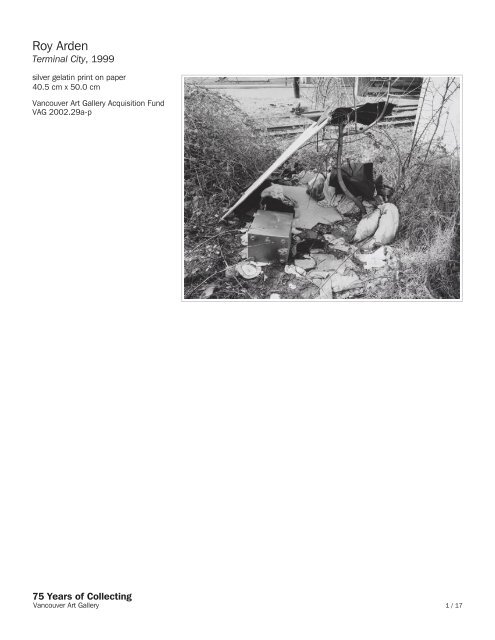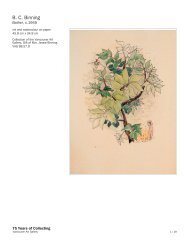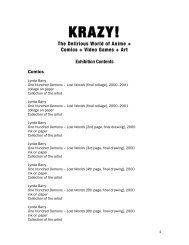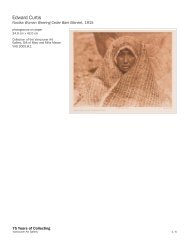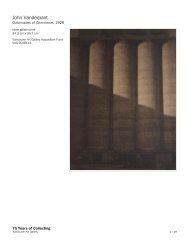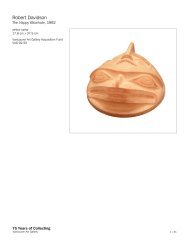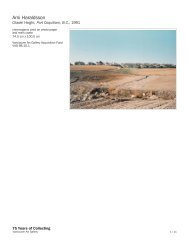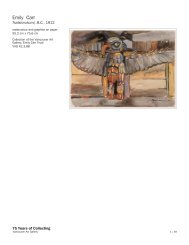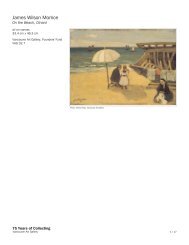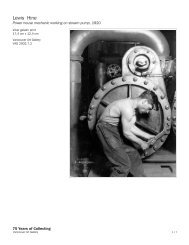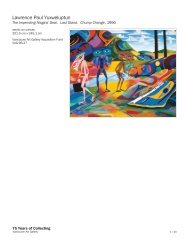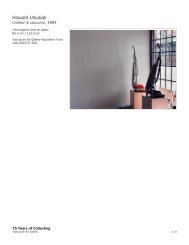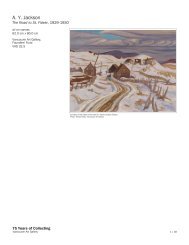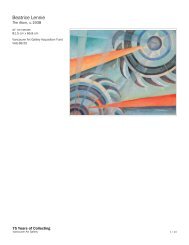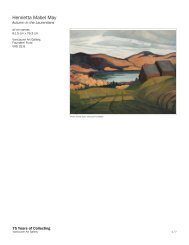Roy Arden - 75 Years of Collecting - Vancouver Art Gallery
Roy Arden - 75 Years of Collecting - Vancouver Art Gallery
Roy Arden - 75 Years of Collecting - Vancouver Art Gallery
Create successful ePaper yourself
Turn your PDF publications into a flip-book with our unique Google optimized e-Paper software.
<strong>Roy</strong> <strong>Arden</strong><br />
Terminal City, 1999<br />
silver gelatin print on paper<br />
40.5 cm x 50.0 cm<br />
<strong>Vancouver</strong> <strong>Art</strong> <strong>Gallery</strong> Acquisition Fund<br />
VAG 2002.29a-p<br />
<strong>75</strong> <strong>Years</strong> <strong>of</strong> <strong>Collecting</strong><br />
<strong>Vancouver</strong> <strong>Art</strong> <strong>Gallery</strong><br />
1 / 17
<strong>Roy</strong> <strong>Arden</strong><br />
Terminal City, 1999<br />
Image source:<br />
http://www.joywebsight.com/images/polaroids/r<br />
oyarden.jpg<br />
<strong>75</strong> <strong>Years</strong> <strong>of</strong> <strong>Collecting</strong><br />
<strong>Vancouver</strong> <strong>Art</strong> <strong>Gallery</strong><br />
<strong>Art</strong>ist's Biography<br />
Nationality: Canadian<br />
Born: 1957, <strong>Vancouver</strong><br />
<strong>Roy</strong> <strong>Arden</strong> was born in 1957 in <strong>Vancouver</strong>, British Columbia. He graduated from<br />
Emily Carr College <strong>of</strong> <strong>Art</strong> and Design with a diploma in 1982 and received a<br />
Master <strong>of</strong> Fine <strong>Art</strong>s at the University <strong>of</strong> British Columbia in 1990. Since the early<br />
1980s <strong>Arden</strong> has exhibited extensively in national and international exhibitions.<br />
Over the past two decades <strong>Arden</strong> has become one <strong>of</strong> Canada's most respected<br />
photo-based artists. Since the early 1990s, <strong>Arden</strong> has been photographing<br />
<strong>Vancouver</strong>'s urban environment, which has become the conduit by which he<br />
explores his interest in local history and modernity. Describing his work from this<br />
period, <strong>Arden</strong> states that it "has been my attempt to register the transformative<br />
effects <strong>of</strong> modernity as they are revealed in any everyday experience <strong>of</strong> the<br />
landscape. Through this work I have also sought to explore and articulate a<br />
Realism which is informed by my understanding <strong>of</strong> tradition. I have drawn on<br />
artists as diverse as [Albrecht] Durer, [Christen] Kobke, [Eugene] Atget, Walker<br />
Evans, Robert Smithson, and [Per] Pasolini. I see this art history as a toolbox <strong>of</strong><br />
tropes, strategies and devices with which I can interpret my experience." <strong>Arden</strong>'s<br />
photographs <strong>of</strong> <strong>Vancouver</strong> streets, houses and industrial lots are perceptive<br />
images that investigate the impact <strong>of</strong> modern and contemporary economies. His<br />
work <strong>of</strong>ten presents images <strong>of</strong> the present that evidence both traces <strong>of</strong> the past<br />
and the abrupt appearance <strong>of</strong> the new. <strong>Arden</strong> is interested in documenting the<br />
"the landscape <strong>of</strong> the economy" by which he means the social and economic<br />
history <strong>of</strong> <strong>Vancouver</strong> and its surrounding areas. In 2000, <strong>Arden</strong> began producing<br />
video works, concerned with many <strong>of</strong> the same themes as his photographic<br />
work.<br />
Source: Acquisitions Justification<br />
<strong>Art</strong>istic Context<br />
Nationality: Canadian<br />
Training: Emily Carr College <strong>of</strong> <strong>Art</strong> & Design; University <strong>of</strong> British Columbia<br />
Peers: Stan Douglas; Ken Lum; Howard Ursuliak; Stephen Waddell<br />
Group: Photoconceptualism; Photography; Video; 20th century; 21st century<br />
Provenance:<br />
Subject: <strong>Vancouver</strong>; urban environment; <strong>Vancouver</strong>'s economic history; urban<br />
development and decay<br />
2 / 17
<strong>Roy</strong> <strong>Arden</strong><br />
Terminal City, 1999<br />
<strong>75</strong> <strong>Years</strong> <strong>of</strong> <strong>Collecting</strong><br />
<strong>Vancouver</strong> <strong>Art</strong> <strong>Gallery</strong><br />
Other Works in the <strong>Vancouver</strong> <strong>Art</strong> <strong>Gallery</strong> Collection<br />
<strong>Roy</strong> <strong>Arden</strong><br />
Rupture, 1985<br />
silver gelatin print on photo paper — fibre base, photo paper - resin coate<br />
<strong>Vancouver</strong> <strong>Art</strong> <strong>Gallery</strong> Acquisition Fund<br />
VAG 86.17 a-i<br />
<strong>Roy</strong> <strong>Arden</strong><br />
Soil Compactor, Richmond, B.C., 1993<br />
chromogenic print on photo paper - resin coate<br />
<strong>Vancouver</strong> <strong>Art</strong> <strong>Gallery</strong> Acquisition Fund<br />
VAG 94.27.1<br />
<strong>Roy</strong> <strong>Arden</strong><br />
Construction Site and "Suntower", <strong>Vancouver</strong>, B.C., 1992<br />
chromogenic print on photo paper —resin coate<br />
<strong>Vancouver</strong> <strong>Art</strong> <strong>Gallery</strong> Acquisition Fund<br />
VAG 94.27.2<br />
<strong>Roy</strong> <strong>Arden</strong><br />
Pulp Mill Dump (#1), Nanaimo, B.C., 1992<br />
chromogenic print on photo paper- resin coate<br />
<strong>Vancouver</strong> <strong>Art</strong> <strong>Gallery</strong> Acquisition Fund<br />
VAG 94.27.3<br />
<strong>Roy</strong> <strong>Arden</strong><br />
Caribbean Festival (#1), <strong>Vancouver</strong>, B. C., 1992<br />
chromogenic print on photo paper — resin coate<br />
<strong>Vancouver</strong> <strong>Art</strong> <strong>Gallery</strong> Acquisition Fund<br />
VAG 94.27.4<br />
<strong>Roy</strong> <strong>Arden</strong><br />
Condominium Advertisement, <strong>Vancouver</strong>, B.C., 1992<br />
chromogenic print on photo paper —resin coate<br />
<strong>Vancouver</strong> <strong>Art</strong> <strong>Gallery</strong> Acquisition Fund<br />
VAG 94.27.5<br />
<strong>Roy</strong> <strong>Arden</strong><br />
Plywood Stacks, <strong>Vancouver</strong>, B.C., 1991<br />
chromogenic print on photo paper —resin coate<br />
<strong>Vancouver</strong> <strong>Art</strong> <strong>Gallery</strong> Acquisition Fund<br />
VAG 94.27.6<br />
<strong>Roy</strong> <strong>Arden</strong><br />
Landfill, Richmond, B.C., 1991<br />
chromogenic print on photo paper- resin coate<br />
<strong>Vancouver</strong> <strong>Art</strong> <strong>Gallery</strong> Acquisition Fund<br />
VAG 94.27.7<br />
<strong>Roy</strong> <strong>Arden</strong><br />
Tree Stump, Nanaimo, B.C., 1991<br />
chromogenic print on photo paper — resin coate<br />
<strong>Vancouver</strong> <strong>Art</strong> <strong>Gallery</strong> Acquisition Fund<br />
VAG 94.27.8<br />
<strong>Roy</strong> <strong>Arden</strong><br />
Model House and Honda Warehouse, Richmond, B.C., 1993<br />
chromogenic print on photo paper —resin coate<br />
<strong>Vancouver</strong> <strong>Art</strong> <strong>Gallery</strong> Acquisition Fund<br />
VAG 94.27.9<br />
3 / 17
<strong>Roy</strong> <strong>Arden</strong><br />
Terminal City, 1999<br />
<strong>75</strong> <strong>Years</strong> <strong>of</strong> <strong>Collecting</strong><br />
<strong>Vancouver</strong> <strong>Art</strong> <strong>Gallery</strong><br />
<strong>Roy</strong> <strong>Arden</strong><br />
Museum <strong>of</strong> Anthropology, UBC, #1,<strong>Vancouver</strong>, B.C., 1991<br />
chromogenic print on photo paper — resin coate<br />
<strong>Vancouver</strong> <strong>Art</strong> <strong>Gallery</strong> Acquisition Fund<br />
VAG 94.27.10<br />
<strong>Roy</strong> <strong>Arden</strong><br />
Pneumatic Hammer #2, <strong>Vancouver</strong>, B.C., 1992, 2000<br />
chromogenic print<br />
Gift <strong>of</strong> Mr. and Mrs. Ken Stephens<br />
VAG 2001.40.1<br />
<strong>Roy</strong> <strong>Arden</strong><br />
House in Strathcona Alley, <strong>Vancouver</strong>, B.C., 1995<br />
chromogenic print on paper<br />
<strong>Vancouver</strong> <strong>Art</strong> <strong>Gallery</strong> Acquisition Fund with the financial support <strong>of</strong> the Canada<br />
Council for the <strong>Art</strong>s Acquisitions Assistance Program<br />
VAG 2001.42.1<br />
<strong>Roy</strong> <strong>Arden</strong><br />
Landfill, Richmond, B.C., 1991<br />
chromogenic print on paper<br />
<strong>Vancouver</strong> <strong>Art</strong> <strong>Gallery</strong> Acquisition Fund with the financial support <strong>of</strong> the Canada<br />
Council for the <strong>Art</strong>s Acquisitions Assistance Proqram<br />
VAG 2001.42.2<br />
<strong>Roy</strong> <strong>Arden</strong><br />
Terminal City, 1999<br />
black and white photograph<br />
<strong>Vancouver</strong> <strong>Art</strong> <strong>Gallery</strong> Acquisition Fund<br />
VAG 2002.29 a-p<br />
<strong>Roy</strong> <strong>Arden</strong><br />
Jeweller's Vitrine, circa 1983<br />
azo dye print<br />
Gift <strong>of</strong> Bill Jeffries<br />
VAG 2004.17.1<br />
<strong>Roy</strong> <strong>Arden</strong><br />
Marble, c.1983<br />
azo dye print on plastic<br />
Gift <strong>of</strong> Bill Jeffries<br />
VAG 2004.17.2<br />
<strong>Roy</strong> <strong>Arden</strong><br />
Soil Compactor, 1992<br />
giclee on paper<br />
<strong>Vancouver</strong> <strong>Art</strong> <strong>Gallery</strong> Acquisition Fund<br />
VAG 2004.37.14<br />
<strong>Roy</strong> <strong>Arden</strong><br />
Citizen, 2000<br />
DVD for projection<br />
Purchased with the financial support <strong>of</strong> the Canada Council for the <strong>Art</strong>s<br />
Acquisition Assistance Program and the <strong>Vancouver</strong> <strong>Art</strong> <strong>Gallery</strong> Acquisition Fund<br />
VAG 2005.15.1<br />
4 / 17
<strong>Roy</strong> <strong>Arden</strong><br />
Terminal City, 1999<br />
<strong>75</strong> <strong>Years</strong> <strong>of</strong> <strong>Collecting</strong><br />
<strong>Vancouver</strong> <strong>Art</strong> <strong>Gallery</strong><br />
Bibliography<br />
Terminal City<br />
Publication<br />
1999<br />
[transcription <strong>of</strong> excerpt]<br />
Notes on Terminal City<br />
"Willows, old rotten planks, slimy posts, and brickwork, I love such things."<br />
John Constable<br />
"In history as in nature, decay is the laboratory <strong>of</strong> life."<br />
Karl Marx<br />
Since 1991 I have been producing colour photographs under the rubric <strong>of</strong> the<br />
Landscape <strong>of</strong> the Economy. This project has been my attempt to register the<br />
transformative effects <strong>of</strong> modernity as they are revealed in an everyday<br />
experience <strong>of</strong> the landscape. Through this work I have also sought to explore<br />
and articulate a realism which is informed by my understanding <strong>of</strong> tradition. I<br />
have drawn on artists as diverse as Dürer, Kobke, Atget, Walker Evans, Robert<br />
Smithson, and Paslini. I see this art history as a toolbox <strong>of</strong> tropes, strategies<br />
and devices with which I can interpret my experience.<br />
Recently, I came to realize that aesthetic problems around the picturesque were<br />
playing a central role in my work. Rustic motifs or tropes in particular were<br />
emerging as useful to the problem <strong>of</strong> depicting traces <strong>of</strong> the lowest socioeconomic<br />
strata in the urban landscape as well as the passage <strong>of</strong> time and<br />
history. An "urban rustic" emerged as a category necessary to an adequate<br />
account <strong>of</strong> modernity. Although a predilection for depicting the lowly or abject<br />
can be traced to the rhyparography <strong>of</strong> the Greek painter Piraeicus who painted<br />
"barber's shops, cobbler's stalls, asses, estables and similar subjects..." it<br />
appears that Constable is the seminal figure for a modern rustic. The moment<br />
that low subjects become matter for high art, a trajectory towards the informe is<br />
initiated. This is the hypothesis that I intuited and sought to examine.<br />
Terminal City is a suite <strong>of</strong> black and white photographs I produced in <strong>Vancouver</strong><br />
in 1999. As an appendix to Landscape <strong>of</strong> the Economy it focuses on the<br />
particular, aesthetic problem <strong>of</strong> the rustic. The title derives from an appellation<br />
denoting <strong>Vancouver</strong> as the end <strong>of</strong> the railway line that made Canadian<br />
Federation a reality. As development <strong>of</strong> the city today continues at a furious<br />
pace, the residue <strong>of</strong> wilderness that survives within the city consequently<br />
diminishes. Most alleyways have been paved and vacant lots occupied in the<br />
war against uncultivated nature. The railway lines are the last underdeveloped<br />
zones and serve as the remaining connection between country and city. Deer<br />
and cougars still occasionally find their way along these routes to magically<br />
appear in the middle <strong>of</strong> the polis. These zones are also the territory <strong>of</strong> the<br />
marginal and dispossessed, the refugees from late capitalism. Atget's ragpickers<br />
have been replaced by the disaffected teenagers, drug addicts, prostitutes, and<br />
the homeless who scrounge for bottles, cans and scrap metal.<br />
At the most literal level Terminal City is a view <strong>of</strong> the city from the bottom, from<br />
the position <strong>of</strong> the discarded or rusticated citizen. However, it is also a<br />
figuration <strong>of</strong> the slide from Constable to Wols—the rustication <strong>of</strong> art. I have<br />
tried to illustrate the historical fall (this evolution could also be imagined as a<br />
dissolution) from the megalographic to the rhyparographic—from high subjects<br />
5 / 17
<strong>Roy</strong> <strong>Arden</strong><br />
Terminal City, 1999<br />
<strong>75</strong> <strong>Years</strong> <strong>of</strong> <strong>Collecting</strong><br />
<strong>Vancouver</strong> <strong>Art</strong> <strong>Gallery</strong><br />
to low subject, and then the destruction <strong>of</strong> illusionistic representation itself. This<br />
decline is presented figuratively through a photographic realism that is limited by<br />
its intrinsically literary character. Because the new urban rustic appears through<br />
photography, an aura <strong>of</strong> forensic evidence has replaced the aura <strong>of</strong> the beauxarts.<br />
Terminal City is preordained by historical necessity to read as a crime story<br />
about modernity and modern art.<br />
<strong>Vancouver</strong>, April 1999<br />
Aspects <strong>of</strong> the Rustic as Trope<br />
[One speaks <strong>of</strong>] "purity" with a people's highly developed sense <strong>of</strong> language,<br />
which, in large society, establishes itself, above all, among the aristocratic and<br />
educated. Here it is decided what is to be considered as provincial, as dialect,<br />
and as normal; viz, "purity", then is positively the customary usage <strong>of</strong> the<br />
educated in society, which received its sanction through the user, and the<br />
"impure" is everything else which attracts attention to it. Thus the "not-striking",<br />
is that which is pure.<br />
(Friedrich Nietzsche, "Description <strong>of</strong> Ancient Rhetoric")<br />
"Feeling, but deaf, seeing, but mute, they go their way. "Thus, Walter Benjamin<br />
on the forces that attract and pull awry. Roused by the influence <strong>of</strong> entropy on<br />
both the course <strong>of</strong> narration and the fated aspect <strong>of</strong> character in Goethe's<br />
Elective Affinities, Benjamin's focus is revealing. Bound to the soil and drawn to<br />
the soil only ins<strong>of</strong>ar as cultivation [Bildung] claims both mastery and distance<br />
from it, one finds hidden within the perspective <strong>of</strong> the landed gentry an<br />
indissoluble relation between sublimation and dissolution. Ironically for<br />
Benjamin, the landed gentry is drawn to the very ground upon which the "pure"<br />
and the "not-striking" is constituted. Nowhere is this tension better evinced than<br />
in the proprietary gaze. In typically Goethean fashion this novel turns upon a<br />
succession <strong>of</strong> striking scenes, eye-catching perspectives, and picturesque views.<br />
Forever falling upon the rustic incident, the "aristocratic and educated" claim to<br />
vision is apparently shot through with the permanence <strong>of</strong> something like the<br />
intractable force <strong>of</strong> gravity. Drawing on the high tradition <strong>of</strong> the tableau and a<br />
model <strong>of</strong> photojournalism, <strong>Roy</strong> <strong>Arden</strong>'s Terminal City embodies precisely this<br />
tension. Following Nietzsche one might submit that the striking and the "notstriking"<br />
are inseparably correlative. In other words the cultivated gaze is one<br />
continuously struck dumb, pulled downward and askew. The cultivated gaze is<br />
suspended in a continual state <strong>of</strong> rustication.<br />
Terminal City occupies a kind <strong>of</strong> supplementary position in <strong>Arden</strong>'s work. It<br />
crystallizes one aspect <strong>of</strong> his almost ten years <strong>of</strong> picture making in the environs<br />
<strong>of</strong> <strong>Vancouver</strong>, British Columbia. It is in this sense continuous with the general<br />
subject matter, motifs, and concerns <strong>of</strong> his "Landscape <strong>of</strong> the Economy" series.<br />
More importantly, however, Terminal City is a formalization <strong>of</strong> this still ongoing<br />
project. The Terminal City suite focuses in on a specific aesthetic issue that<br />
might be usefully summed up as a morphology <strong>of</strong> the striking; a morphology <strong>of</strong><br />
the striking approach to the practice <strong>of</strong> depiction one sees in the latter series.<br />
Never simply the product <strong>of</strong> a roving or vigi-<br />
lant "I" on the look out for a good shot, the color photographs from the<br />
"Landscape <strong>of</strong> the Economy" series—a photograph like Tree Stump, Nanaimo,<br />
B. C., 1991 for instance—are rather the product <strong>of</strong> a subject who has just taken<br />
a painful shot to the eye. Always transitional sites—landscapes which register<br />
the economy or history, spaces and objects <strong>of</strong> modernization as much as<br />
deterioration—these pictures hinge on the question <strong>of</strong> the eye-sore: things that<br />
have struck, hooked, or caught the eye in a prehensile manner. "There are, in<br />
6 / 17
<strong>Roy</strong> <strong>Arden</strong><br />
Terminal City, 1999<br />
<strong>75</strong> <strong>Years</strong> <strong>of</strong> <strong>Collecting</strong><br />
<strong>Vancouver</strong> <strong>Art</strong> <strong>Gallery</strong><br />
general, very peculiar magnitudes attached to the objects depicted and the axes<br />
or direction from which they are seen that set up the conditions <strong>of</strong> a particularly<br />
charged specular relation. Terminal City takes up the essentially tropological<br />
nature <strong>of</strong> the latter series by literally framing the wider question <strong>of</strong> salience or<br />
strikingness in terms <strong>of</strong> the problem <strong>of</strong> historical emergence: a problem which is<br />
always governed by the turn toward the object, i.e., the turn toward rustication.<br />
Simply put, <strong>Arden</strong> traces that historical transference or transition from an origin<br />
in the picturesque to a tendency in the informe. Mirroring an insipid decline that<br />
proceeds apace with development, Terminal City figures the convention <strong>of</strong> the<br />
rustic by narrating the modalities <strong>of</strong> its progressive enfeeblement. It is a<br />
peculiarly Western trajectory, the origins <strong>of</strong> which lead back from our own<br />
modernity, to the Romantic period, and ultimately to the birth <strong>of</strong> the ancient<br />
Hesperos itself. Thus at the very origin <strong>of</strong> the Platonic city—the city <strong>of</strong><br />
philosophers, Athens—one finds the expulsion or exile <strong>of</strong> the poets to the<br />
country. "Sent-down" or "banished" from the polis, what Heidegger calls "the<br />
place <strong>of</strong> history, the there in which, from which, and for which history takes<br />
place"—the poetic condition par excellence is that <strong>of</strong> rustication. Etymology is<br />
obviously helpful here. Out <strong>of</strong> rustication one dregs up a precious, eroded<br />
history. The crux <strong>of</strong> <strong>Arden</strong>'s project turns on a self-critical perspective that opens<br />
up the instant <strong>of</strong> time to this very history. With an eye for seeking out the signs<br />
<strong>of</strong> time—the course <strong>of</strong> ruination, or <strong>of</strong> nature in decay more generally—his<br />
practice turns on the rustication <strong>of</strong> what Nietzsche calls "the customary usage <strong>of</strong><br />
the educated in society." These pictures circulate between the polarities <strong>of</strong> high<br />
and low, and one cannot but be struck by the swift and irresistible attraction that<br />
continuously pulls them toward the object in its dissolution.<br />
Rusticity is continually capturing the attention. Functioning in terms <strong>of</strong> a<br />
condition <strong>of</strong> possibility for salience itself, it seems the very motor behind the act<br />
<strong>of</strong> conjuration or depiction. In each individual photograph, it is with an almost<br />
palpable sense <strong>of</strong> the circuitry between attraction and repulsion that impurity<br />
strikes that which the eye has already sanctioned as pure, or that the eye is<br />
drawn down to the level <strong>of</strong> the detail and raised up again by this self-same<br />
concentration on the medium. In the Terminal City suite as a whole, narration<br />
proceeds down a scale <strong>of</strong> ever worsening notes that turn upon ever heightened<br />
acts <strong>of</strong> sublimation. The concomitance <strong>of</strong> these divergent imperatives is clear.<br />
An overgrown garage borders on the picturesque. Via a crooked path the<br />
rusticity <strong>of</strong> a northern settlement creeps up on the inner city. A miserable<br />
"queen-size" bed holds court among the weeds. A pathetic array <strong>of</strong> spent<br />
condoms shuttle between their abject status and the height <strong>of</strong> modernist<br />
abstraction. Quite literally pictures <strong>of</strong> tropes, one comes upon the rustic<br />
conventions <strong>of</strong> Constable, Atget, Zille, Evans, Wols, Pollock, Smithson, Sherman<br />
and Wall alike, only to stumble over the photojournalistic model in which <strong>Arden</strong>'s<br />
photographs are uniformly couched. Phenomenologically speaking, the rustic<br />
turn is the mirror <strong>of</strong> a continual process<br />
<strong>of</strong> falling into time and place. As the turn to consciousness itself, the action <strong>of</strong><br />
rustication is the essential history that <strong>Arden</strong>'s work sounds out.<br />
Drifting from trope to trope in a periodic and discontinuous progression that<br />
intends consciousness, transplanted from the rural to an urban setting which the<br />
cultivated have learned to abhor, the educated viewer is urged through an act <strong>of</strong><br />
mimesis to take up the lowly habits <strong>of</strong> a tramp. Positioned somewhere between<br />
the disinterested gaze <strong>of</strong> the Reverend Gilpin and the furtive glance <strong>of</strong> a<br />
ragpicker one roots along picturesque backalleys, through blighted woods,<br />
vacated sidings, and down eroded trails. Heavy with a sense <strong>of</strong> the day-to-day<br />
routine, these are pictures haunted by dispossession. Neither the sublime nor<br />
the beautiful is at stake here. What is at issue, is the affect-laden charge<br />
animating the relation between them. This tension, which is central to the<br />
picturesque, draws the eye continuously down from sublimity toward the object<br />
<strong>of</strong> rustication; from a cold and implacable landscape to the object or detail shot<br />
7 / 17
<strong>Roy</strong> <strong>Arden</strong><br />
Terminal City, 1999<br />
<strong>75</strong> <strong>Years</strong> <strong>of</strong> <strong>Collecting</strong><br />
<strong>Vancouver</strong> <strong>Art</strong> <strong>Gallery</strong><br />
through with a rough, ramshackle, and <strong>of</strong>ten scatological charm. Divided and<br />
paradoxical, these photographs work hard to body forth a threshold condition. By<br />
superseding that dialectic which has traditionally structured discussions <strong>of</strong><br />
photography in terms <strong>of</strong> the binary construction between the document and art,<br />
they lay bare a kind <strong>of</strong> fugitive predicament. This fugitiveness, wherein visuality<br />
swings so wildly between the terms <strong>of</strong> its possibility that the current on which it<br />
flows is itself rendered opaque, is central to grasping <strong>Arden</strong>'s work. It is the crux<br />
<strong>of</strong> any Realist art worth the name.<br />
As a rhetorical practice, the essential condition <strong>of</strong> Realism is an ironic one. It is<br />
grounded in nothing more nor less than a double bind. It is consubstantial with<br />
nothing other than the process <strong>of</strong> historical emergence. Occupying a heterotopic<br />
condition (both in the individual image and in the suite as a whole), <strong>Arden</strong>'s<br />
Realism narrates the passing or transitive movement which shuttles a dissolute<br />
materiality into meaning. This circuitry between opposites underwrites the<br />
disembedding leap into figuration which is metaphor. As an absence at the heart<br />
<strong>of</strong> figuration, a kind <strong>of</strong> harmonic interval, the transit in question is none other<br />
than the action or process <strong>of</strong> turning that is the trope. Holding up a perfect<br />
mirror to the world, it mouths the riddle with which Nietzsche begins Ecce Homo:<br />
"I am ... already dead as my father, while as my mother I am still living and<br />
becoming old". As an embodiment <strong>of</strong> the exchange relation itself, the condition<br />
<strong>of</strong> Realism is a mirror <strong>of</strong> the subject's own constitution. Terminal City figures the<br />
passing <strong>of</strong> a trope. It narrates the modalities <strong>of</strong> that essential history (now) in<br />
which being comes to nothing.<br />
Perhaps the key question with which the viewer is faced hinges upon how one is<br />
to read this narrative <strong>of</strong> emergence that is at once a dissolution. The relation to<br />
the cinematographic and the work <strong>of</strong> Jeff Wall is obviously important here. More<br />
to the point is the imperative within photography as "the most transparent <strong>of</strong> art<br />
mediums" toward what Clement Greenberg has called the "literary". That the<br />
arch defender <strong>of</strong> abstraction in painting should call for photography to be<br />
"literary" should be <strong>of</strong> little surprise." The fact is, that unlike the medium <strong>of</strong><br />
painting, photography as a modernist art was felt on the most essential level to<br />
be constituted through depiction. It was Walker Evans' achievement to have<br />
struck a deep lyric note within the very form <strong>of</strong> the prosaic. For a critic who had<br />
long wished a great realist painter would arrive on the scene possessed <strong>of</strong> all the<br />
expressivity <strong>of</strong> high modernist abstraction, Greenberg's praise for Evans should<br />
not add to the confusion. Hardly a new Titian, Evans had revealed that the<br />
historical instant <strong>of</strong> time housed within it a potentially speculative movement.<br />
If one views this movement through the optic <strong>of</strong> Greenberg's commitment to<br />
color, one might pr<strong>of</strong>itably think <strong>of</strong> this imperative internal to photography's<br />
indexical sign in terms <strong>of</strong> a banishment, or indeed rustication from the<br />
constraints <strong>of</strong> the Platonic city. As a loss <strong>of</strong> language's communicative potential,<br />
a spiraling downward from surface appearance into depth, the time honored<br />
trope <strong>of</strong> rustication has since the very dawn <strong>of</strong> the West, gnawed away at all that<br />
is "True" and "Good" under the Platonic sun. Set in opposition to the Agora,<br />
against the academy, and closely allied with Greenberg's own work against<br />
mimesis, the "literary" in <strong>Arden</strong>'s photography is a meta-temporal movement or<br />
narrative drive consubstantial with the entropic action <strong>of</strong> Greenberg's favorite<br />
word: "dissipate", Though <strong>of</strong> course, one would have to distinguish Greenberg's<br />
more thoroughgoing idealism on the question <strong>of</strong> materialism from that <strong>of</strong><br />
<strong>Arden</strong>'s, which is almost certainly in the tradition <strong>of</strong> Bataille's base materialism.<br />
We are confronted by what Yves-Alain Bois has called the imperative toward<br />
"declass(ify)ing": here, through the caprice <strong>of</strong> classifying types <strong>of</strong> subject matter<br />
that span the history <strong>of</strong> the trope <strong>of</strong> rustication.<br />
If at one time photography was tied in some substantive way to its subject<br />
matter, in the context <strong>of</strong> <strong>Arden</strong>'s work the vertiginous aspect <strong>of</strong> the gaze troubles<br />
or rusticates the mimetic function all the while keeping the task <strong>of</strong> depiction<br />
8 / 17
<strong>Roy</strong> <strong>Arden</strong><br />
Terminal City, 1999<br />
<strong>75</strong> <strong>Years</strong> <strong>of</strong> <strong>Collecting</strong><br />
<strong>Vancouver</strong> <strong>Art</strong> <strong>Gallery</strong><br />
intact. <strong>Arden</strong>'s is a project steeped within the Realist tradition that strives to<br />
draw out the idea <strong>of</strong> mimesis upon which it is based. Much that is tempting to<br />
read into <strong>Arden</strong>'s work — all that intends upon subject matter and<br />
thematization; all that emphasizes a moribund social history <strong>of</strong> the region — can<br />
be categorically dismissed in terms <strong>of</strong> its inability to comprehend the level upon<br />
which history gains entrance, is insinuated within, or has a purchase on the<br />
practice <strong>of</strong> depiction. History animates this photography on the most literal level<br />
<strong>of</strong> depiction, a mythic level that is one with the constitutive moment <strong>of</strong> the<br />
medium and simultaneous to its dissolution.<br />
Take Hastings Street Sidewalk, <strong>Vancouver</strong>, B. C., 1996 as only one possible<br />
ending. Like many <strong>of</strong> <strong>Arden</strong>'s outdoor pictures it literalizes the process or action<br />
<strong>of</strong> turning itself. By undermining a number <strong>of</strong> established perspectival<br />
conventions the sidelong glance renders a repressed history in all its immediacy.<br />
Once the bustling center <strong>of</strong> <strong>Vancouver</strong>, now a rotten core, Hastings Street lays<br />
claim to the corporeal. Marked by a kind <strong>of</strong> convexity or mounding up <strong>of</strong> the<br />
picture plane, the surface itself seems to embody the bulbous pressure <strong>of</strong><br />
watery eyes in a convulsive fit. All one need do is inhabit this hunch-back glance<br />
in passing ... Eyes askew ... Chest aheave ... Overhanging porticulus ... Tastes<br />
like bile in the morning to me! Charged with the effects <strong>of</strong> marginal distortion,<br />
surfeit with a radical foreshortening and vanishing point too low and too close,<br />
absolutely loaded with what the great Leonardo described as "every false relation<br />
and disagreement <strong>of</strong> proportion that can be imagined in a wretched work," a<br />
history <strong>of</strong> the street rises like a sickening lump in ones throat. One can but think<br />
<strong>of</strong> Milton in 1642 on the occasion <strong>of</strong> his rustication from the University <strong>of</strong><br />
Cambridge: not simply "sent down" or "banished" to the country, but as he put it<br />
"vomited out into a Suburbe sinke". With every look the rustication <strong>of</strong> the gaze<br />
renders the cultivated figure an expression <strong>of</strong> historical will. Mirroring its own<br />
emergence it seems the figure can but reflect on the root and soil <strong>of</strong> its own<br />
history: the striking, the figure-making trope, the dissolute, the informe, the<br />
rustic.<br />
Further Reading<br />
Coleman, A.D. "<strong>Roy</strong> <strong>Arden</strong>," The Promise <strong>of</strong> Photography. Munich: Prestel,<br />
1998.<br />
<strong>Roy</strong> <strong>Arden</strong>. <strong>Vancouver</strong>: Contemporary <strong>Art</strong> <strong>Gallery</strong>, 1993.<br />
<strong>Roy</strong> <strong>Arden</strong>. North York: <strong>Art</strong> <strong>Gallery</strong> <strong>of</strong> York University, 1997.<br />
<strong>Roy</strong> <strong>Arden</strong>: Fragments, Photographs, 1981-1985. North <strong>Vancouver</strong>:<br />
Presentation House <strong>Gallery</strong>, 2002.<br />
West: <strong>Roy</strong> <strong>Arden</strong>. <strong>Vancouver</strong>: <strong>Art</strong>speak <strong>Gallery</strong>, 1988.<br />
9 / 17
<strong>Roy</strong> <strong>Arden</strong><br />
Terminal City, 1999<br />
<strong>75</strong> <strong>Years</strong> <strong>of</strong> <strong>Collecting</strong><br />
<strong>Vancouver</strong> <strong>Art</strong> <strong>Gallery</strong><br />
Exhibition History<br />
Exhibitions at the <strong>Vancouver</strong> <strong>Art</strong> <strong>Gallery</strong><br />
<strong>75</strong> <strong>Years</strong> <strong>of</strong> <strong>Collecting</strong>: The Road to Utopia. September 16, 2006 - January 1,<br />
2007.<br />
Selected Exhibitions Outside <strong>of</strong> the <strong>Vancouver</strong> <strong>Art</strong> <strong>Gallery</strong><br />
Centro de Fotografia, Universidad de Salamanca, Salamanca. Terminal City.<br />
1999<br />
Galerie Max Hetzler, Berlin. Objects in The Rear View Mirror May Appear Closer<br />
Than They Are. 1999<br />
Monte Clarke <strong>Gallery</strong>, <strong>Vancouver</strong>. Terminal City. Febrary 15, 2000 - March 4,<br />
2000<br />
Gilles Peyroulet & Cie, Paris. <strong>Roy</strong> <strong>Arden</strong>. April 26, 2000 - May 29, 2000.<br />
Dee/Glasoe <strong>Gallery</strong>, New York. Terminal City. 2001<br />
Ikon <strong>Gallery</strong>, Birmingham U.K. <strong>Roy</strong> <strong>Arden</strong>. February 1, 2006 - March 2006.<br />
Archival History<br />
Press Release<br />
Miscellaneous History<br />
2000<br />
[transcription]<br />
MONTE CLARK GALLERY VANCOUVER<br />
2339 GRANVILLE ST VANCOUVER BC CANADA V6H 3G4 TEL 604 730<br />
5000 FAX 604 730 5050<br />
<strong>Roy</strong> <strong>Arden</strong> Terminal City<br />
February 15 through March 4, 2000<br />
Opening reception: Tuesday, February 15 6-8 PM <strong>Art</strong>ist will be in<br />
attendance<br />
<strong>Roy</strong> <strong>Arden</strong>'s Terminal City series was previously shown at Max Hetzler Galerie,<br />
Berlin, and the Centro De Fotografia [Fotographia], Salaminca[Salamanca],<br />
Spain, which also produced a catalogue devoted to the work.<br />
Comprised <strong>of</strong> 16 black and white photographic prints, Terminal City is most<br />
literally understood as a view <strong>of</strong> <strong>Vancouver</strong> from the bottom. <strong>Arden</strong> has<br />
photographed those traces <strong>of</strong> untamed nature that still remain within the<br />
borders <strong>of</strong> the expanding city. The alleyways, railway lines, vacant lots and other<br />
areas that have escaped the attentions <strong>of</strong> developers and planners constitute a<br />
sort <strong>of</strong> shadow realm or otherworld, utilized by society's most marginalized<br />
people: prostitutes, drug-users, the homeless and teen-agers. Wildlife such as<br />
coyotes and deer also travel the railway lines that connect country and city to<br />
10 / 17
<strong>Roy</strong> <strong>Arden</strong><br />
Terminal City, 1999<br />
<strong>75</strong> <strong>Years</strong> <strong>of</strong> <strong>Collecting</strong><br />
<strong>Vancouver</strong> <strong>Art</strong> <strong>Gallery</strong><br />
magically appear in the middle <strong>of</strong> the busy polis. The title <strong>of</strong> the series invoices<br />
<strong>Vancouver</strong>'s status as the "end <strong>of</strong> the line"— the terminus <strong>of</strong> the railway system<br />
that made Canadian Confederation possible.<br />
But Terminal City is also an allegory <strong>of</strong> art's slide from realism to the informe or<br />
formlessness <strong>of</strong> postwar abstraction. <strong>Arden</strong>'s compositions and tropes quote<br />
artists and photographers from Constable to Atget to Wols. The idea is that the<br />
introduction <strong>of</strong> low subjects into high art set in motion an unstoppable and<br />
necessary dissolution <strong>of</strong> the painted tableau. <strong>Arden</strong>'s previous major <strong>Vancouver</strong><br />
exhibition was <strong>of</strong> his large colour photographs <strong>of</strong> the 'landscape <strong>of</strong> the economy',<br />
(at the Belkin <strong>Gallery</strong> at U.B.C.). Terminal City evolved from this work as an<br />
appendix that addresses the aesthetic category <strong>of</strong> the 'urban rustic'.<br />
For further information or visual materials please contact Brad Beattie at<br />
604.730.5000<br />
<strong>Gallery</strong> Hours: Tuesday through Saturday 10 to 6<br />
<strong>Art</strong>ist will be in attendance<br />
Newspaper Clipping<br />
Miscellaneous History<br />
2000<br />
[transcription]<br />
A terrible Terminal City<br />
A powerful new body <strong>of</strong> work by internationally acclaimed photographer<br />
<strong>Roy</strong> <strong>Arden</strong> exposes <strong>Vancouver</strong>'s harsh poverty and endemic drug use.<br />
TERMINAL CITY<br />
New photographs by <strong>Roy</strong> <strong>Arden</strong>.<br />
Monte Clark <strong>Gallery</strong>, 2339 Granville, to Mar. 4.<br />
MICHAEL SCOTT<br />
SUN VISUAL ART CRITIC<br />
We are by nature an optimistic species, moulding our lives to the belief that a<br />
better tomorrow is just around the corner. For a long time, the road to that<br />
happy day has led westward, through Avalon and the mystic Misty Isles, to the<br />
New World and inevitably to this far Pacific shore. And every last one <strong>of</strong> the<br />
teeming millions arriving at the western terminus <strong>of</strong> their journey has imagined a<br />
better life here.<br />
How could they not? Look around at the affluent precincts <strong>of</strong> the city and its<br />
clear-complexioned burghers, at the traffic jams <strong>of</strong> luxury automobiles and the<br />
euphoric crowds <strong>of</strong> shoppers. Is this not the New Jerusalem, the promised land<br />
<strong>of</strong> milk and Prada honey?<br />
Of course, there is a cost to paving paradise — the downside <strong>of</strong> putting up the<br />
parking lot. There is pr<strong>of</strong>ound poverty here and endemic drug use; there is a<br />
degraded environment and a cycle <strong>of</strong> failure and stunted expectation. The same<br />
11 / 17
<strong>Roy</strong> <strong>Arden</strong><br />
Terminal City, 1999<br />
<strong>75</strong> <strong>Years</strong> <strong>of</strong> <strong>Collecting</strong><br />
<strong>Vancouver</strong> <strong>Art</strong> <strong>Gallery</strong><br />
optimism that keeps us searching for a better tomorrow can also blind us to<br />
today's prevailing horrors.<br />
It is this terrifying frontier between hope and futility that forms the theme <strong>of</strong> a<br />
powerful new body <strong>of</strong> work by <strong>Vancouver</strong> photographer <strong>Roy</strong> <strong>Arden</strong>. Terminal City<br />
is a suite <strong>of</strong> 16 black-and-white photographs that leads us down to the wrong<br />
side <strong>of</strong> the tracks, to a muddy wedge <strong>of</strong> alder slash and cardboard shelters that<br />
is the very end <strong>of</strong> the line.<br />
Over much <strong>of</strong> the past decade, <strong>Arden</strong> has sought to document the effects <strong>of</strong><br />
development (or "modernism" as he describes it) on the landscape in which we<br />
live: a body <strong>of</strong> photographs, entitled Landscape <strong>of</strong> the Economy, that has<br />
brought the philosophical artist international attention. Those images <strong>of</strong> monster<br />
houses and uprooted woodlots have focused on what our voracious appetites<br />
have done to the land beneath our feet. The new images <strong>of</strong> Terminal City look at<br />
the human costs <strong>of</strong> progress.<br />
The bottoming out <strong>of</strong> individual hopes — abandoning any pretense <strong>of</strong><br />
participating in a cash economy— ends in homelessness and dumpster diving, a<br />
poverty <strong>of</strong> the spirit so dire that in going about our daily rounds we either step<br />
past it, ignoring it, or dismiss it as the unfortunate symptom <strong>of</strong> mental illness.<br />
What <strong>Arden</strong> shows us, in a descending gyre <strong>of</strong> imagery, is something far more<br />
abject. The detritus <strong>of</strong> these lives, lived out amidst rotting mattresses and the<br />
rag ends <strong>of</strong> personal possessions, is a sad reminder that the human spirit must<br />
gutter first before it is completely extinguished.<br />
Our journey to the end <strong>of</strong> the road begins with a view <strong>of</strong> the railway itself, the<br />
agent that deposited so many hundreds <strong>of</strong> thousands <strong>of</strong> newcomers and their<br />
hopes — on this rain-soaked shore. <strong>Arden</strong> shows the sweep <strong>of</strong> the rail line next<br />
to the grubby consequences — the one a gesture writ large across the face <strong>of</strong> a<br />
city; the other a cautionary tale told in individual stanzas. Terminal City No. 2,<br />
for instance, shows the back <strong>of</strong> two frame houses, and the rail right-<strong>of</strong>-way that<br />
forms their property line. A well-worn path leads down to the rails from the road<br />
above, through a dense scrub <strong>of</strong> blackberry bramble. The ground is littered with<br />
garbage, the area a kind <strong>of</strong> no-man's-land through which innumerable<br />
neighbourhood kids have played and platoons <strong>of</strong> homeless have rummaged.<br />
Terminal City No. 3 is a closer view <strong>of</strong> the pathway, showing us a bit <strong>of</strong> carpet,<br />
or perhaps a soiled blanket, ground into the dirt. Other views show storage<br />
sheds, or ramshackle garages, near collapse and muffled with the pernicious<br />
blackberry brambles that seem a constant clement <strong>of</strong> <strong>Arden</strong>'s work. The plant<br />
itself, introduced here from Asia at the turn <strong>of</strong> the last century, is a relentless<br />
colonizer, one that frequently establishes itself on disturbed or degraded ground.<br />
<strong>Arden</strong> then leads us deeper into the heart <strong>of</strong> this particular darkness, to the leantos<br />
and cardboard shelters <strong>of</strong> its otherwise homeless inhabitants. Whether in a<br />
roadside wedge <strong>of</strong> trees or beneath a sheltering loading bay, people have made<br />
some sad effort to make a room for themselves — a mattress hauled out <strong>of</strong><br />
sight <strong>of</strong> the roadway; a sleeping bag carefully laid out in the midst <strong>of</strong> a bramble<br />
thicket; a few planks and some paper scraps dragged under a loading dock.<br />
It is hard to know how to take these images, which inspire a wide array <strong>of</strong><br />
emotions. On one hand there is distress at imagining the discomfort <strong>of</strong> these<br />
displaced lives; on another a sense <strong>of</strong> wonder that the human spirit can endure,<br />
however feebly, in the face <strong>of</strong> such adversity. <strong>Arden</strong> himself speaks in terms <strong>of</strong> a<br />
variety <strong>of</strong> rustic life that springs up in the wake <strong>of</strong> urban development. "Most<br />
alleyways have been paved and vacant lots occupied in the war against<br />
uncultivated nature," he writes in a catalogue essay. "The railway lines are the<br />
last underdeveloped zones and serve as the remaining connection between<br />
country and city. Deer and cougars still occasionally find their way along these<br />
routes to appear in the middle<br />
12 / 17
<strong>Roy</strong> <strong>Arden</strong><br />
Terminal City, 1999<br />
<strong>75</strong> <strong>Years</strong> <strong>of</strong> <strong>Collecting</strong><br />
<strong>Vancouver</strong> <strong>Art</strong> <strong>Gallery</strong><br />
<strong>of</strong> the [city]. These zones are also the territory <strong>of</strong> the marginal and<br />
dispossessed, the refugees from late capitalism.<br />
"[The 19th century's] rag pickers have been replaced by the disaffected<br />
teenagers, drug addicts, prostitutes, and the homeless who scrounge for bottles,<br />
cans and scrap metal."<br />
In the end <strong>Arden</strong> runs us to ground, in the same way that his invisible subjects<br />
have reached their own last resort. The exhibition's most powerful images are <strong>of</strong><br />
the mud underfoot in these lonely, and woebegone places — a terrain so utterly<br />
denatured as to make one's heart ache with shame. Here the landscape <strong>of</strong> the<br />
primeval forest has been reduced to muddy<br />
footing for illicit sex with a partner pushed up against a chain-link fence. The<br />
ground is covered in used condoms, oily rainwater, sodden and pulpy tissues<br />
and other shards <strong>of</strong> misery. Words fail to convey the horror <strong>of</strong> it, <strong>Arden</strong> seems to<br />
say in Terminal City No. 14, which shows the busted-up carcass <strong>of</strong> a typewriter<br />
sunk in the oozing mud.<br />
<strong>Arden</strong>'s images are terrifying in their reminder that the end <strong>of</strong> any road can be a<br />
bitter place to live. They show us a landscape <strong>of</strong> failure all the more acute for<br />
the conspicuous affluence that hems it in on all sides.<br />
Newspaper Clipping<br />
Miscellaneous History<br />
2000<br />
[transcription <strong>of</strong> excerpt]<br />
Life on the Edge<br />
BY SARAH MILROY<br />
Photography is not always what it seems. In <strong>Vancouver</strong>, one <strong>of</strong> the world<br />
centres for new work in this protean medium, Jeff Wall has for some time now<br />
been pioneering new photographic hybrids that play fast and loose with our<br />
conventional notions <strong>of</strong> realism. Images are digitally combined and reformulated<br />
in an almost painterly play on time-honoured pictorial traditions.<br />
<strong>Roy</strong> <strong>Arden</strong>, a native <strong>Vancouver</strong>ite more than 10 years Wall's junior, represents a<br />
countervailing tendency. A photographer, sessional teacher, writer<br />
and occasional curator <strong>of</strong> exhibitions, he is doing much to formulate the next<br />
generation <strong>of</strong> photo art to come out <strong>of</strong> the West.<br />
Like Wall, <strong>Arden</strong> has a shrewd and diagnostic eye for the cityscape around him,<br />
and his work <strong>of</strong> the past nine years — a series titled Landscape <strong>of</strong> the Economy<br />
— goes far to map the ravages <strong>of</strong> economic expansion in the Lower Mainland <strong>of</strong><br />
B.C. But unlike Wall, who creates digital tableaux to respond to just such<br />
histories or to elaborate his narratives, <strong>Arden</strong> takes to the streets, camera in<br />
hand, to see what he can find.<br />
The results are deeply evocative <strong>of</strong> the specifics <strong>of</strong> urban culture in <strong>Vancouver</strong>.<br />
His new series, on show at The Monte Clarke <strong>Gallery</strong> in <strong>Vancouver</strong> until March 4,<br />
takes us through a specific aspect <strong>of</strong> the city: its abandoned railway lines and<br />
wild urban spaces that harbour both human and animal vagrants.<br />
The current show, titled Terminal City, takes its name from <strong>Vancouver</strong>'s early<br />
designation as the end <strong>of</strong> the railway line. These pictures show us how the city<br />
remains a kind <strong>of</strong> end point to this day, a final destination for what <strong>Arden</strong><br />
13 / 17
<strong>Roy</strong> <strong>Arden</strong><br />
Terminal City, 1999<br />
<strong>75</strong> <strong>Years</strong> <strong>of</strong> <strong>Collecting</strong><br />
<strong>Vancouver</strong> <strong>Art</strong> <strong>Gallery</strong><br />
describes as the "refugees from late capitalism."<br />
But <strong>Arden</strong> is tangling with more than just a sense <strong>of</strong> locale in these pictures. "I'm<br />
interested in the history <strong>of</strong> realism that runs through art history from John<br />
Constable in the 19th century onwards," says <strong>Arden</strong>, "although <strong>of</strong> course you<br />
can say that realism starts with the Romans."<br />
In particular, <strong>Arden</strong> has fastened on the idea <strong>of</strong> the rustic. As he was working on<br />
Landscape <strong>of</strong> the Economy, "the rustic just kept cropping up, motifs like the<br />
bramble hedge or the collapsed hut — images <strong>of</strong> natural decay or <strong>of</strong> something<br />
man made being taken over by nature." The pictures came from <strong>Arden</strong>'s thinking<br />
about this tradition as he walked the railway lines <strong>of</strong> <strong>Vancouver</strong> and explored its<br />
urban fringes. "As I started thinking and reading about it, I realized that this idea<br />
also is central to the photography <strong>of</strong> Atget, or Walker Evans."<br />
Asked about Terminal City #3, <strong>Arden</strong> describes the picture as a direct<br />
descendent <strong>of</strong> Constable, structured as it is around the winding path that<br />
"literally drags the viewer's eye through the depth <strong>of</strong> perspectival illusion" — a<br />
traditional device <strong>of</strong> the pastoral picturesque. At the right, we see the spill <strong>of</strong><br />
brambles, the rotting, leaning fence post, and the frame house — a 20thcentury<br />
update on the British rustic worker's cottage nestled in the bosom <strong>of</strong><br />
nature.<br />
<strong>Arden</strong>'s work will find detractors in those who quail at his aestheticising <strong>of</strong> the<br />
abject. It is an insoluble quandary, but the artist is the first to examine his own<br />
motives.<br />
"There was a famous essay written in Constable's day which jumps all over this,"<br />
says <strong>Arden</strong>, "the argument that 'This is someone else's misery that you are<br />
making pretty.' But art history is full <strong>of</strong> this. How do you explain the paradox <strong>of</strong> a<br />
beautiful painting <strong>of</strong> a dead child?" The Impressionists painted factories and<br />
drunks and beggars, he argues, although that is not normally how they are<br />
remembered. "As soon as you accept that there are certain things you can't<br />
show you are in trouble. It's equating the picture with what is being depicted:'<br />
What is being depicted, in this case, is the landscape <strong>of</strong> <strong>Arden</strong>'s youth. "Most<br />
people grow up at the edge <strong>of</strong> the city, because young families are pushed to<br />
the margins. I grew up in South <strong>Vancouver</strong> at Southwest Marine and Cambie," a<br />
modest residential area bordering on the Fraser River, along which much <strong>of</strong> the<br />
city's industry now resides, <strong>Arden</strong> remembers. "We were surrounded by huge<br />
vacant lots. Across the street, we could look from our house and see workers in<br />
coolie hats in the vegetable fields. All <strong>of</strong> a sudden this all disappeared, and it<br />
was replaced by car showrooms and McDonald's and furniture showrooms.<br />
<strong>Arden</strong>'s pictures make us think about the forces that propel such change. We<br />
are the wiser for it.<br />
Terminal City continues at the Monte Clark <strong>Gallery</strong> in <strong>Vancouver</strong> to March 4<br />
14 / 17
<strong>Roy</strong> <strong>Arden</strong><br />
Terminal City, 1999<br />
<strong>75</strong> <strong>Years</strong> <strong>of</strong> <strong>Collecting</strong><br />
<strong>Vancouver</strong> <strong>Art</strong> <strong>Gallery</strong><br />
Acquisitions Justification<br />
Acquisition Record<br />
2002<br />
[transcription]<br />
<strong>Roy</strong> <strong>Arden</strong><br />
b. 1957, <strong>Vancouver</strong>, BC<br />
Lives and works in <strong>Vancouver</strong>, BC<br />
Terminal City, 1999<br />
16 black and white photographs<br />
16 x 20 inches, edition <strong>of</strong> 3 (framed)<br />
Vendor: Painter Editions Inc.<br />
Provenance: The <strong>Art</strong>ist<br />
Exhibited: Monte Clark <strong>Gallery</strong>, <strong>Vancouver</strong>; Max Hetzler Galerie, Berlin;<br />
Dee/Glasoe, New York; and the Centro De Fotografia, Salamanca, Spain, which<br />
also produced a catalogue devoted to the work.<br />
<strong>Art</strong>ist Biography<br />
Photo-based <strong>Vancouver</strong> artist <strong>Roy</strong> <strong>Arden</strong> graduated from Emily Carr College <strong>of</strong><br />
<strong>Art</strong> and Design with a diploma in 1982 and received his Master <strong>of</strong> Fine <strong>Art</strong>s from<br />
the University <strong>of</strong> British Columbia in 1990. Since the early 1980s <strong>Arden</strong> has<br />
been included in solo and group exhibitions nationally and internationally. His<br />
solo exhibitions include those at Oakville Galleries, Oakville, Ontario, (2002);<br />
Dee/Glasoe, New York (2001); Gilles Peyroulet & Cie, Paris (2001); Patrick<br />
Painter Inc., Santa Monica (2000); Monte Clark <strong>Gallery</strong>, <strong>Vancouver</strong> (2000);<br />
Presentation House <strong>Gallery</strong>, North <strong>Vancouver</strong> (2000); Centro de Fotografia,<br />
Universidad de Salamanca, Salamanca (1999); lllingworth Kerr <strong>Gallery</strong>, Alberta<br />
College <strong>of</strong> <strong>Art</strong> and Design, Calgary (1998); <strong>Art</strong> <strong>Gallery</strong> <strong>of</strong> York University, Toronto<br />
(1997); Morris and Helen Belkin <strong>Gallery</strong>, University <strong>of</strong> British Columbia (1997);<br />
American Fine <strong>Art</strong>s Co., New York (1996); Contemporary <strong>Art</strong> <strong>Gallery</strong>, <strong>Vancouver</strong><br />
(1993); Galerie Giovanna Minelli, Paris (1990); OR <strong>Gallery</strong>, <strong>Vancouver</strong> (1990);<br />
Hippolyte <strong>Gallery</strong>, Helsinki (1989); <strong>Art</strong>speak, <strong>Vancouver</strong> (1998); YYZ <strong>Art</strong>ists<br />
Outlet, Toronto (1987); Dazibao, Montreal (1987); Coburg <strong>Gallery</strong>, <strong>Vancouver</strong><br />
(1985, 1983). Group exhibitions include those at Kunsthalle Baden-Baden<br />
(2002), <strong>Vancouver</strong> <strong>Art</strong> <strong>Gallery</strong> (2001, 1987, 1984, 1983); Museu d'<strong>Art</strong><br />
Contemporani de Barcelona (2001); Centre national de la photographie, Paris<br />
(2001); 11th Biennale <strong>of</strong> Sydney, Sydney (1998); Suermondt Ludwig Museum,<br />
Aachen (1998); Canadian Centre for Contemporary Photography (1997); Musée<br />
Municipal de La Roche- sur-Yon, and Musée des Beaux-<strong>Art</strong>s et FRAC Franche-<br />
Comte, Dole, France (1993); Fotographie Biennale Rotterdam, Perspektief<br />
(1990); <strong>Art</strong> <strong>Gallery</strong> <strong>of</strong> Ontario, Toronto (1989). <strong>Arden</strong> is represented by Monte<br />
Clark <strong>Gallery</strong>.<br />
<strong>Art</strong>ist in Context<br />
Since the early 1990s <strong>Roy</strong> <strong>Arden</strong> has been making photographs <strong>of</strong> <strong>Vancouver</strong>'s<br />
urban environment. Describing his work from this period, <strong>Arden</strong> states that it<br />
"has been my attempt to register the transformative effects <strong>of</strong> modernity as they<br />
are revealed in any everyday experience <strong>of</strong> the landscape. Through this work I<br />
have also sought to explore and articulate a Realism which is informed by my<br />
understanding <strong>of</strong> tradition. I have drawn on artists as diverse as Durer, Kobke,<br />
Atget, Walker Evans, Robert Smithson, and Pasolini. I see this art history as a<br />
15 / 17
<strong>Roy</strong> <strong>Arden</strong><br />
Terminal City, 1999<br />
<strong>75</strong> <strong>Years</strong> <strong>of</strong> <strong>Collecting</strong><br />
<strong>Vancouver</strong> <strong>Art</strong> <strong>Gallery</strong><br />
toolbox <strong>of</strong> tropes, strategies and devices with which I can interpret my<br />
experience." <strong>Arden</strong>'s photographs <strong>of</strong> <strong>Vancouver</strong> streets, houses and industrial<br />
lots are perceptive images that investigate the impact <strong>of</strong> modern and<br />
contemporary economies.<br />
Work Under Consideration<br />
Comprised <strong>of</strong> 16 black and white photographic prints, Terminal City is most<br />
literally understood as a view <strong>of</strong> <strong>Vancouver</strong> looking up from the bottom. <strong>Arden</strong><br />
has photographed persistent "non-progressive" elements that remain within the<br />
borders <strong>of</strong> the expanding city: the alleyways, railway lines, vacant lots and other<br />
areas that have escaped the attention <strong>of</strong> developers and planners. These areas<br />
have been allowed to remain as-is because they exist on the margins <strong>of</strong> the city,<br />
bordering on a lower socio-economic realm. These spaces are commonly<br />
inhabited by prostitutes, drug-users, homeless and teenagers, while<br />
simultaneously providing a pathway between the city and country by which<br />
wildlife such as coyotes travel.<br />
The title <strong>of</strong> this series, Terminal City, invokes <strong>Vancouver</strong>'s status as the locale at<br />
"end <strong>of</strong> the line" — the terminus <strong>of</strong> the railway system that made Canadian<br />
Confederation possible. It has also been noted that the title is an allegory <strong>of</strong> art's<br />
slide from realism to the formlessness <strong>of</strong> postwar abstraction and the<br />
introduction <strong>of</strong> low subjects into high art. <strong>Arden</strong> engages with these ideas in part<br />
by quoting other artists and photographers from Constable to Atget to Wols by<br />
picturing marginal subject matter through an almost forensic methodology.<br />
<strong>Arden</strong>'s 1997 exhibition at the Morris and Helen Belkin <strong>Gallery</strong> at UBC <strong>of</strong> colour<br />
photographs<br />
(depicting a 'landscape <strong>of</strong> the economy') was the jumping <strong>of</strong>f point for Terminal<br />
City. Terminal City evolved from this earlier series in order to address the<br />
aesthetic category <strong>of</strong> the 'urban rustic'. <strong>Arden</strong> recognized the aesthetic problems<br />
around representing the picturesque. He writes, "Rustic motifs... were emerging<br />
as useful to the problem <strong>of</strong> depicting traces <strong>of</strong> the lowest socioeconomic strata<br />
in the urban landscape as well as the passage <strong>of</strong> time and history. An 'urban<br />
rustic' emerged as a category necessary to an adequate account <strong>of</strong> modernity."<br />
<strong>Arden</strong> considers these photographs to be "portraits," capable <strong>of</strong> telling stories <strong>of</strong><br />
times past. For example, some <strong>of</strong> the houses seen in Terminal City are from an<br />
early <strong>Vancouver</strong> era and speak to a time when the economy <strong>of</strong> this part <strong>of</strong> the<br />
west coast was driven by natural resources especially the forest industry. These<br />
vestiges <strong>of</strong> history exist in the midst <strong>of</strong> a furiously developing city and <strong>Arden</strong>'s<br />
work occupies this moment <strong>of</strong> tension between stagnation and change, between<br />
low and high, figuration and abstraction to occupy a critical position on changing<br />
notions <strong>of</strong> the modern.<br />
Justification<br />
The <strong>Vancouver</strong> <strong>Art</strong> <strong>Gallery</strong> currently has 13 works by <strong>Arden</strong> in the collection. The<br />
acquisition <strong>of</strong> this suite <strong>of</strong> photographs would significantly enhance the<br />
comprehensive nature <strong>of</strong> the <strong>Gallery</strong>'s <strong>Arden</strong> holdings and bring a more recent<br />
body <strong>of</strong> his work into the collection. The work has strong links to other<br />
contemporary photo-based work in the collection, both by local artists (Christos<br />
Dikeakos, Stan Douglas, Scott McFarland, Jeff Wall, Ian Wallace) as well as by<br />
international artists (Bernd and Hilla Becher, Andreas Gursky, Thomas Ruff).<br />
Recommend purchase.<br />
Daina Augaitis<br />
Chief Curator/ Associate Director<br />
Research: Melanie O'Brian<br />
Assistant Curator<br />
16 / 17
<strong>Roy</strong> <strong>Arden</strong><br />
Terminal City, 1999<br />
<strong>75</strong> <strong>Years</strong> <strong>of</strong> <strong>Collecting</strong><br />
<strong>Vancouver</strong> <strong>Art</strong> <strong>Gallery</strong><br />
Terms and Conditions<br />
The images, texts, documentation, illustrations, designs, icons and all other<br />
content are protected by Canadian and international copyright laws. The content<br />
may be covered by other restrictions as well, including copyright and other<br />
proprietary rights held by third parties. The <strong>Vancouver</strong> <strong>Art</strong> <strong>Gallery</strong> retains all<br />
rights, including copyright, in data, images, text and any other information. The<br />
<strong>Gallery</strong> expressly forbids the copying <strong>of</strong> any protected content, except for<br />
purposes <strong>of</strong> fair dealing, as defined by Canadian copyright law.<br />
17 / 17


